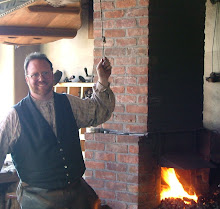The summer of 2009 was the 3rd year of our Scottish Pistol Masterpiece Project. The 4 smiths working on the project had completed a barrel the previous summer, with the finish work occurring over the winter. Now it was time to make the flintlock mechanism for the pistol.
The lock mechanism is both complex and finely fitted. Every part was forged from wrought iron bar or steel. For this style of pistol, the lock plate has a standard shape, but not a set size. The forged and filed lock plate is fitted precisely to the forged and filed stock. The internal parts of the mechanism are forged from iron bar and then filed to shape as well. Here are rough forgings for the springs.
The end result needs to fit so precisely that engraving can flow over the stock and right onto the lock plate as if it were only one piece of metal. The pivot points were located and drilled. Then work began on making all of the parts. Illustrations of how a flint lock mechanism works can be seen at here.
Another array of parts are located on the inside of the lock plate and are responsible for making the hammer fall when the trigger is pulled. The sear and sear spring connect the trigger to the hammer mechanism. The sear’s job is to prevent the hammer from being actuated until the trigger has been pulled. Once the sear is tripped, the mainspring throws the hammer and flint forward into the frizzen, and hopefully creates sparks that fire the powder in the pan and the main charge in the pistol.
Creating the lock for the pistol is a very challenging project. The shape of each part and the location of each mounting hole and each screw effects every other part. Changing the shape of a sear, hammer, or spring by 1/32th of an inch can make the difference between a pistol that fires and one that doesn’t. The Scottish Pistol Project has been an exciting chance to research and build a lock using the same materials and tools as the Gunsmiths in Doane, Scotland in 1740.







I really like this project.
ReplyDeleteI have done some smithing and I want to build a flintlock rifle. Not the barrel, but the metal furniture and fittings. Do you have dimensions and thoughts that would help?
Our method is to find or take good photos and drawings of 2-3 originals of a specific style. Learn their similarities and key features. Then start drawing and forging pieces to match that style. That will give you a piece tied to a specific time in history and different from more generic copies. What time period and location do you enjoy most?
ReplyDeleteI've been reading this series of posts with great interest. I want to get into blacksmithing with the intention of eventually branching out to traditional gunsmithing. What are some tips you would have to give to someone who is new to this?
ReplyDeleteGreat work! I've been making locks from scratch and I was wondering if you've come across a site with this interest. I would like to post progress and pictures with fellow builders. I am a member of a large muzzleloading forum and have posted my work with almost no reply. They're centered on building rifles from bought parts and I guess they have no interest in forging there own parts or in my doing so.
ReplyDeleteI've read this blog quite a few times and it's really great. The only thing I have'nt done yet is a barrel. My first pistol is a 12 ga. double. I copied my 1728 french infantry rifles lock for the right and made an oppisite for the left. The only thing I bought was the barrels. It is some fun to shoot and hunt with. My newest project is a 1807 An IX De Gendarmerie officers pistol. I just completed the lock.
Please let me know.
I have built a bunch of locks in the past and am building another bunch now. Although four of them are rifle size, I've decided to make six or eight small locks (4" long). I don't have any specific guns in mind, just locks right now.
DeleteTHANKU ---STUNNING WORK --
ReplyDeletedo you allow anyone to use your blueprints --/?
WOULD love to build this lock --can u give me any dimensions to work from?---built crossbow triggers --but still learning flintlock trigger mechanisms --reall struggling --failed due to no blueprints
thanku ---- Carl
cannot find patterns or dimensions of flintlocks on a hundred sites I have scrutinised --
ReplyDeletecan anyone supply me with blueprints of a basic flintlock mechanism ---size of springs /metal type /thickness etc --would really appreciate
(built black powder mini cannons --lit by fuse ---nasty
would love to convert to flintlock !
thanku ---- Carl
great artistic creativity--in steel ?-
ReplyDeletelovely work --but are you u using stainless steel ?
or just polished mild steel ?
er ---I cannot see the TRIGGER anywhere ---does it
bolt on separately?---please show the trigger set up
thankyou ---inspiring ----wow !